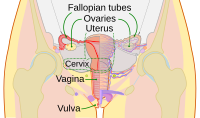
Photo from wikipedia
OBJECTIVE To assess the risk for obstetric complications in women with congenital uterine anomalies and the risk in each main class of uterine anomaly (U2 [septate], U3 [bicorporeal], U4 [hemi-uterus]),… Click to show full abstract
OBJECTIVE To assess the risk for obstetric complications in women with congenital uterine anomalies and the risk in each main class of uterine anomaly (U2 [septate], U3 [bicorporeal], U4 [hemi-uterus]), based on the 2013 classification by the ESHRE (European Society of Human Reproduction and Embryology) and the ESGE (European Society for Gynaecological Endoscopy). DATA SOURCES MEDLINE, Scopus, and ClinicalTrials.gov were searched from inception until January 2021. The reference list of all included articles and previous systematic reviews were also screened to identify potential additional articles. METHODS OF STUDY SELECTION Comparative and noncomparative studies that investigated the obstetric outcomes of women with any type of known congenital uterine anomaly were considered eligible for inclusion. Screening and eligibility assessment was performed independently by two reviewers. TABULATION, INTEGRATION, AND RESULTS Forty-seven studies were included. The quality of included comparative studies was assessed using the Newcastle-Ottawa Quality Assessment Scale. Odds ratios (ORs), pooled proportions of each obstetric outcome, and 95% CIs were calculated in RevMan and Stata accordingly, using random effects models. Congenital uterine anomalies were associated with increased risk of preterm birth (OR 3.89, 95% CI 3.11-4.88); cervical insufficiency (OR 15.13, 95% CI 11.74-19.50); prelabor rupture of membranes (OR 2.48, 95% CI 1.38-4.48); fetal malpresentation (OR 11.11, 95% CI 5.74-21.49); fetal growth restriction (OR 3.75, 95% CI 1.88-7.46); placental abruption (OR 5.21, 95% CI 3.34-8.13); placenta previa (OR 4.00, 95% CI 1.87-8.56); placental retention (OR 1.71, 95% CI 1.16-2.52); and cesarean birth (OR 4.52, 95% CI 2.19-9.31); when compared with those without anomalies. Pooled estimated risks were 25% for preterm birth, 40% for fetal malpresentation, 64% for cesarean birth, 12% for prelabor rupture of membranes, 15% for fetal growth restriction, 4% for placental abruption, 5% for preeclampsia, 13% for cervical insufficiency, and 2% for placenta previa. Classes U2 (septate), U3 (bicorporeal), and U4 (hemi-uterus) were also associated independently with preterm birth, fetal malpresentation, cesarean birth, and placental abruption. CONCLUSION Congenital uterine anomalies are associated with obstetric complications across all examined ESHRE and ESGE classifications. SYSTEMATIC REVIEW REGISTRATION PROSPERO, CRD42021244487.
Journal Title: Obstetrics and gynecology
Year Published: 2021
Link to full text (if available)
Share on Social Media: Sign Up to like & get
recommendations!